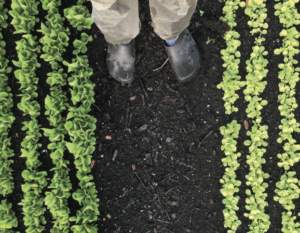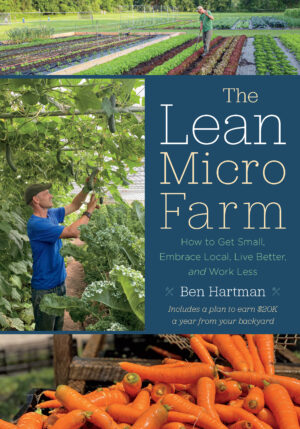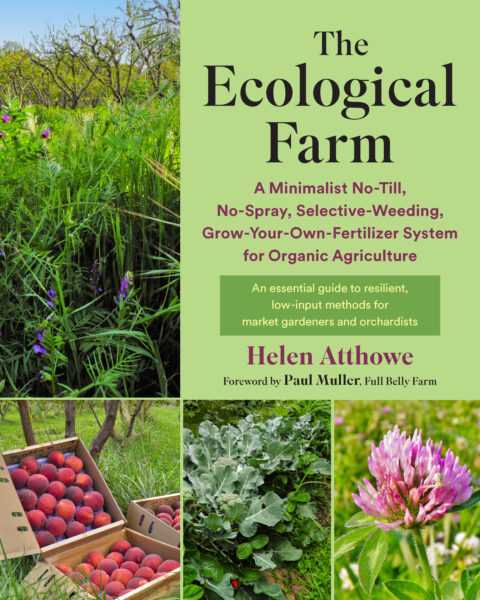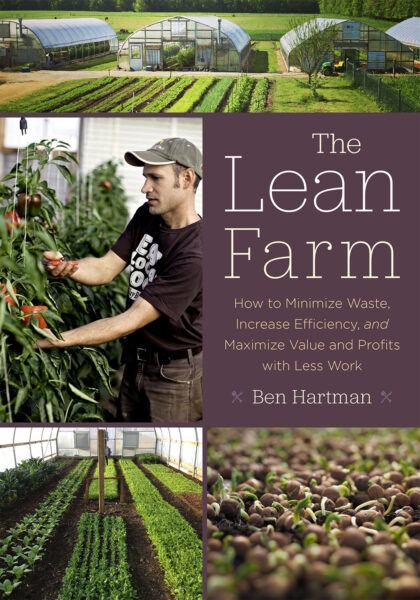Simplify Farm Fieldwork: Stop Working So Hard
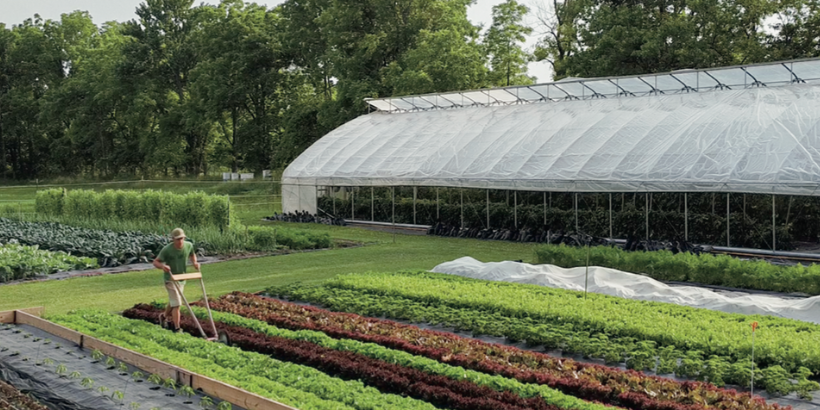
Looking to simplify fieldwork on your farm? The key is to act like a tree: stop working so hard and let nature do some of the work for you.
The following is an excerpt from The Lean Micro Farm by Ben Hartman. It has been adapted for the web.
Unless otherwise noted, all photographs and illustrations copyright © 2023 by Clay Bottom Farm.
Farm Like a Tree: Simplify Fieldwork
A single tree, though it never moves, can be astoundingly productive. Mature pecan and chestnut trees produce about 100 pounds of nuts in a single season; a healthy apple tree will grow 15 bushels of apples in a year; a sugar maple tree, in a good season, will deliver 20 gallons of sap.
How do they do it? In the past few years, we have planted hundreds of trees on our farm, reforesting areas that we are not using to grow crops. I’ve observed and thought a lot about trees recently. Here are four observations that I think help explain their productivity.
1. Trees Work Ahead
Trees can be so productive because they spend years preparing. The fruit and nut trees that we planted, for example, use their first few seasons to create a strong scaffold of branches before producing heavy loads of fruit. They prepare ahead for high productivity.
Similarly, we’ve learned that it is better to set up carefully before jumping into production.
Before our season begins, we take stock, making sure we have ordered enough (but not too many) row covers, clamshell contain- ers, tomato boxes, and other supplies that we will need in the months ahead.
As I write this, in the midwinter, we are preparing to transplant tomatoes in a greenhouse in March. We are disinfecting trays, landscape fabric, and the germination chamber and taking inventory of labels, stakes, and other supplies necessary for the job.
We work ahead in the field, too. If we want to use a bed in the spring, we’ll prepare it in the fall, adding compost months ahead of when the bed will be planted. (The compost itself was made at least a year ahead.)
We have more time in the fall, so we are less rushed and more likely to do a better job. It is best not to farm in the moment, when you are prone to always playing catch-up. Think ahead and prepare.
2. Trees Leave Plant Matter In Place
Trees understand the value of a dead leaf. A full-grown maple tree has about 500 square feet of leaves weighing about 500 pounds.
The total chloroplast surface area of a single tree equals about 140 square miles—an impressive solar array. By fall, these leaves are full of carbon, nitrogen, phosphorus, potassium, calcium, and other nutrients.7
It is a great tragedy that so many people feel compelled to throw leaves in the trash—or, worse yet, to burn them.
The trees we planted don’t move their leaves. They just let them drop and decompose in-situ, in their origi- nal place, to feed themselves and organisms in the soil life.
Many gardeners move dead plants out of the garden at the end of the season to clean up the garden and supposedly prevent disease.
For many years, because of what we were taught, we cleaned up in the fall like this, pulling plants, roots and all, and moving them to a compost heap.
Now we take a different approach. As much as practical, we let old plants decompose in place, where minerals from their leaves, stalks, and roots feed the soil, like a tree.
3. Trees Practice Quiescence
Conventional wisdom says that trees in winter are dormant to conserve energy. Aboveground, this is mostly true, but new research shows that belowground is a different story.
Michael Snyder, writing for Northern Woodlands magazine, explains, “Tree roots seem to maintain a readiness to grow independent of the abo- veground parts of the tree. That is, roots remain mostly inactive but can and do function and grow during winter months whenever soil temperatures are favorable, even if the air aboveground is brutally cold.”
This is called winter quiescence, where roots are resting but ready.
It is a survival tactic important for the health of the tree. “It is this trait that allows evergreens to absorb soil water and avoid winter desiccation in their needles,” writes Snyder. Quiescence “allows all species, including decidu- ous hardwoods, the opportunity to expand their root systems in search of water and nutrients in advance of spring bud break.”8
On a farm, winter is a great time to both rest and expand.
Days are shorter, and there is less work to do. It’s important to sleep more and work less.
But the cold season is also the best time to explore new growing techniques, redesign tools, and visit other farms to learn new skills in preparation for the spring. Trees are a case study proving it is possible to rest and prepare at the same time.
Notes
- Joseph R. Heckman, Daniel Kluchinski, and Donn A. Derr, “Plant Nutri- ents in Municipal Leaves,” Rutgers Cooperative Research and Extension, Fact Sheet FS824, 2004, accessed November 16, 2022, https://sustainable-farming.rutgers.edu/wp-content/uploads/2014/09 /Municipal_Leaves_Plant_Nutrients_Available_FS824_1998.pdf.
- Micheal Snyder, “What Do Tree Roots Do in Winter?,” Northern Woodlands, December 1, 2007, accessed November 16, 2022, https:// northernwoodlands.org/articles/article/what_do_tree_roots_do _in_winter.
Recommended Reads
Recent Articles
Garden strawberries are excellent for both covering the ground and for growing fruit. If you’re planning out a forest garden, or are just looking for a plant to use as ground cover, strawberries are a great option. The following is an excerpt from The Home-Scale Forest Garden by Dani Baker. It has been adapted for…
Read MoreAsparagus is a delicious vegetable with a layered history. How did this aspiring spear make its way from growing in the wild to appearing on our plates? The following is an excerpt from the The Seed Detective by Adam Alexander. It has been adapted for the web. “Nature gives us the key to every secret…
Read MoreInterested in growing trees? Here are some tips on successfully planting, transplanting, and pruning trees to create a flourishing forest garden! The following is an excerpt from The Home-Scale Forest Garden by Dani Baker. It has been adapted for the web. Planting Potted Trees and Shrubs If you order potted trees, check with your supplier to…
Read MoreWith the right strategies and practices, composting on a small farm is surprisingly easy and inexpensive. Just follow these steps for making compost, and your farm will be thriving in no time! The following excerpt is from The Lean Farm Guide to Growing Vegetables by Ben Hartman. It has been adapted for the web. (All photographs by Ben…
Read MoreGarlic mustard: while known as “invasive,” this plant can be consumed in its entirety and has great nutritional value. Plus, the garlic-flavor is a perfect addition to any recipe that calls for mustard! The following are excerpts from Beyond the War on Invasive Species by Tao Orion and The Wild Wisdom of Weeds by Katrina…
Read More

